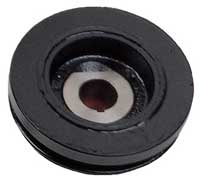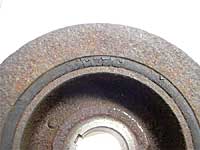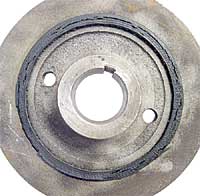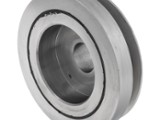Are you familiar with the term ‘torsional vibration’? Well, torsional vibration is simply a periodic vibration which would result from the twisting of an object around its axis. In your Mini engine, this vibration would be expected to originate from the crankshaft as the engine tries to turn it. Excessive torsional vibration, however, is unwanted because it may cause various damages not only to the crankshaft but to the engine itself. Simply put, each time that the air/fuel mixture is ignited within the engine’s cylinders, the combustion causes an extreme amount of cylinder pressure. This cylinder pressure is applied to the pistons and then to the connecting rods and is transferred to the crankshaft. This downward force makes the crankshaft turn. Because this pressure is so great, it produces a torsion vibration from the pistons and incorporated with the crankshaft vibrations causes the crankshaft to twist and deflect causing an action referred to as "tortional harmonic vibration." 
The Mini harmonic balancer is a component that attaches to the front end of your engine's crankshaft to prevent torsional vibration. Also called crank pulley damper or vibration damper, a harmonic balancer is actually made up of three parts: a steel inner part which bolts to the crankshaft; a steel outer part that has a groove for the belt; and a rubber disk in between the two steel parts. As the engine tries to turn the crankshaft, it ends up twisting the rubber part of the damper instead. Thus, twisting of the crankshaft is prevented and its smooth rotation is ensured.
If torsional vibration is not controlled, and it can be to a degree, premature main bearing wear and possibly main journal wear on your crankshaft can occur. This can even cause crankshaft breakage. The vibrations that occur in your engine are not just a threat to engine failure caused by metal fatigue, they are torque and horsepower robbers. If you can reduce engine vibration, you can eliminate power robbing effects such as spark scatter and you can improve valve timing accuracy. Think about it for a second, if the crankshaft is vibrating, it is the vibrations that are transferred through the timing set (timing chain, timing belt, gear drive) to the camshaft, to the rocker arms, to the valves. . Don’t be confused by the phrase “harmonic balancer.” The damper is to control harmonic vibrations, not necessarily to balance the engine’s rotating assembly. The balanced rotating assembly depends on the crankshaft, rods, etc.. The Mini engine must be internally balanced and only uses the damper for harmonic control. The harmonic balancer can efficiently prevent excessive torsional vibration, but only if it is in good working condition. Once damaged or worn out, it could cause fatigue and fracture of the crankshaft, destruction for the couplings, and inefficiency for the engine. Once damaged or worn out, it is advisable that it be replaced immediately.Mini Dampers were made in a couple configurations but in almost all cases a visual inspection of the rubber ring within the damper can predict it’s effectiveness. Pictures below are 2 examples of dampers that absolutely should be replaced.
The BMW MINI Cooper & Cooper S engines have Vibration Dampers that also function as the front pulley. The technical method of balancing the vibrations of the engine are a little more sophisticated but are all still internal in the pulley.
Click for larger image!










